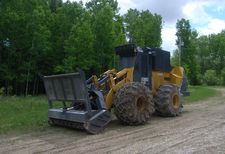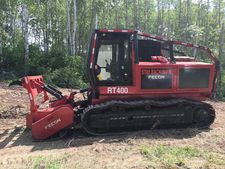Overgrown trees are the second most common reason for power outages. Tree branches that contact power lines can cause electrical shorts, bring down power lines and even start fires. To prevent outages and safety hazards, we need to make sure vegetation is a safe distance from electrical infrastructure.
Vegetation management isn’t just a preventative tool. By keeping trees and brush clear of power lines and poles and maintaining a clear right of way (ROW), it’s easier for our crews to see where a problem might be during an outage and access the equipment to restore power.
Vegetation management is about keeping the public and our workers safe, preventing power outages and making it easier to restore power outages if they happen.
We run an integrated vegetation management program that consists of three different methods around our electrical infrastructure: mechanical brush clearing, selective herbicide applications and tree trimming and removals.
The following map shows where our forestry crews are working and what kind of vegetation management they’ll be doing in the current fiscal year.
If the problem continues, you may need to disable your ad blockers to view the map.
Mechanical brush clearing
Mechanical brush clearing is an important facet of our vegetation management strategy and involves clearing all trees, shrubs and brush on a power line ROW. We use a combination of machinery to execute this program.

An example of a wheeled vehicle used for mechanical brush clearing.

An example of a tracked vehicle used for mechanical brush clearing.
We use mechanical brush clearing primarily in rural locations, but sometimes in urban settings where these machines can be safely managed. This method keeps vegetation away from electrical infrastructure, makes maintenance easier and ensures that emergency vehicles can safely pass through.
When trees are within a certain distance of power lines, we’ll arrange for utility arborists to trim the trees to a safe distance before mechanical brush clearing. We call this ‘topping.’
Mechanical clearing equipment is large, loud and often unsafe to be near because of the potential for flying debris. If you see this work occurring, do not approach a working machine and stay away from the work site. Our crews will have construction signage posted when working along roadways.
Mechanical brush clearing goes hand-in-hand with our use of selective herbicides. After we finish mechanical brush clearing, we use specific chemicals that target tall tree species, preventing them from growing back up and into electrical infrastructure. If trees have grown too tall for herbicide application, mechanical trimming often follows.
Selective herbicides/chemical management
After brush clearing, we apply specific herbicides to prevent problematic trees from growing back to the same levels. These herbicides won’t kill grasses, shrubs and other vegetation. They are applied after the area has grown for at least one year and limit the spray to locations where cut trees have started to regrow.
Using these selective herbicides means the electrical infrastructure continues to be a safe distance from vegetation. It’s also more efficient and effective than mechanical clearing, which often allows trees to regrow from stumps and roots. We only apply these products to specific risk-posing trees. All the herbicides we use are registered products in Canada under the Pest Control Products Act and are also approved for use on our Pesticide Use Permit (PUP).
Tree trimming and removal
Wherever possible, we try to trim branches rather than remove whole trees. Several things determine whether a tree will be removed:
- the tree’s location in relation to the electrical infrastructure — whether it’s beside or underneath, for example.
- the species of tree and its characteristics — how fast it grows, where it’s likely to grow and how likely it is to die or fall over later in life
- the health of the tree after trimming — there are specific requirements for how far away a tree should be from electrical infrastructure, and if the level of trimming required would kill the tree eventually, we’ll opt to remove it now and avoid a future incident
Some trees are not compatible with electrical infrastructure. For example, elms, maples, and willows are fast-suckering species, so if they grow directly under power lines, they’ll likely need to be completely removed to prevent hazards.
If we trim trees in an emergency, we won’t have time to use a utility arborist and our focus will be on removing the problem branches for safety and reliability. Crews that trim trees in an emergency will not clean up the branches when they’re done. This is why it’s so important to maintain vegetation before it grows too close to electrical infrastructure and becomes a problem.
